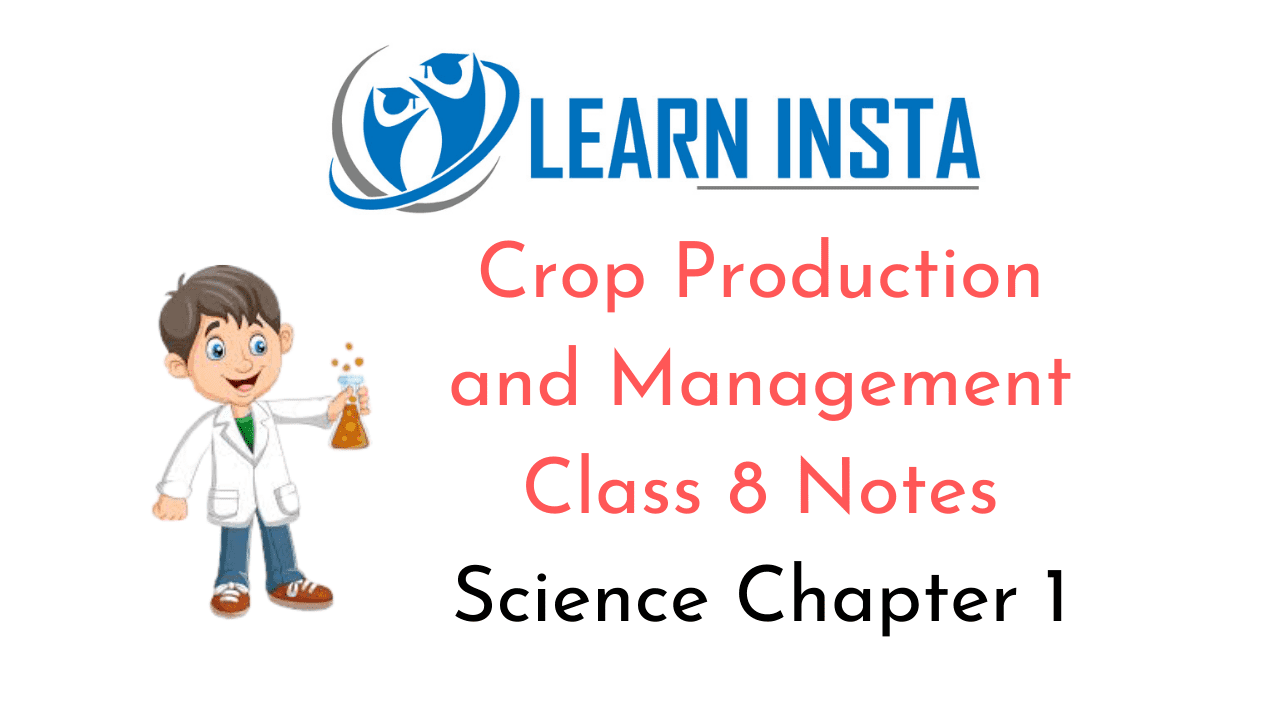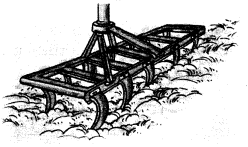
On this page, you will find Crop Production and Management Class 8 Notes Science Chapter 1 Pdf free download. CBSE NCERT Class 8 Science Notes Chapter 1 Crop Production and Management will seemingly help them to revise the important concepts in less time.
CBSE Class 8 Science Chapter 1 Notes Crop Production and Management
Crop Production and Management Class 8 Notes Understanding the Lesson
1. The branch of science that deals with growing plants and raising livestock for human use is called agriculture.
2. When plants of same kind are grown and cultivated at one place on a large scale, it is called a crop.
3. The products obtained from the crops are called produce.
4. The crops grown in India can be classified as kharif and rabi crops.
5. Kharif crops are sown in the rainy season by June/July, and are harvested by September/October. Thus, they are also known as summer season crops. For example, rice, maize, cotton, pulses, etc.
6. Rabi crops are sown in the winter season in October or November and are harvested by March/April. For example, wheat, potato, barley, etc.
7. Agricultural practices are those practices which involve the necessary steps to be taken during production of crops.
8. Important steps that are taken during crop production are:
- Preparation of soil
- Sowing
- Adding manure and fertilisers
- Irrigation
- Protecting from weeds
- Harvesting
- Storage
9. The preparation of soil is the first step before growing a crop. One of the most important tasks in agriculture is to turn soil and
loosen it.
10. The loosening of soil allows roots to penetrate deep into the soil.
11. The process of loosening and turning of the soil is called tilling or ploughing. Ploughing is either done by a plough or a tractor.
12. Hoe is a simple tool which is used for removing weeds and for loosening the soil.
13. Levelling is the process of breaking down the larger lumps of soil, and then levelling it by using a leveller.
14. Sowing is the most important part of crop production. Before sowing, good quality of seeds are selected.
15. The tool used traditionally for sowing seeds is shaped like funnel. Nowadays the seed drill is used for sowing with the tractors. This tool sows the seeds uniformly.

16. Continuous growing of crops makes the soil poorer in certain nutrients.
17. The substances which are added to the soil in the form of nutrients for the healthy growth of plants are called manure and fertilisers.
18. Manure is an organic substance obtained from the decomposition of plant or animal wastes.
19. Fertiliser is a chemical substance which is rich in a particular nutrient. Fertilisers are produced in factories. Some examples of fertilisers are urea, ammonium sulphates, superphosphate, etc.
20. The use of fertilisers helps farmer to get better yield of crops such as wheat, paddy and maize whereas manure improves soil texture as well as its water retaining capacity.
21. Excessive use of fertilisers makes soil less fertile. Fertilisers also leads to water pollution.
22. The organic manures is considered better than fertilisers.
23. The supply of water to crops at different intervals is called irrigation.
24. The time and frequency of irrigation varies from crop to crop, soil to soil and season to season.
25. The sources of irrigation are wells, tubewells, ponds, lakes, rivers, dams and canals.
26. The various traditional ways for irrigation are:
- moat (pulley-system)
- chain pump
- dhekli
- rahat (lever system)
27. Modern methods of irrigation help us to use water economically. Modern methods of irrigation are sprinkler system and drip system.
28. Sprinkler system is more useful on the uneven land where sufficient water is not available.
29. In drip system the water falls drop by drop just at the position of the roots.
30. The undesirable plants that grow naturally along with the crop are called weeds. Weeds compete with the crop plant for nutrients, space and sunlight.
31. The process of removal of weeds is called weeding.
32. The growth of weeds is controlled by using certain chemicals, called weedicides.
33. Weedicides are sprayed in the field to kill the weeds.
34. The process of cutting of crop after it is mature is called harvesting.
35. Harvesting in our country is either done manually by using sickle or by a machine called harvester.
36. The process of separating the grain seeds from the chaff is known as threshing.
37. The process of threshing is carried out with the help of a machine called combine which is in fact a combined harvester and thresher.
38. Farmers with small holdings of land do the separation of grain and chaff by the process of winnowing.
39. The large scale storage of grains is done in silos and granaries to protect them from pests like rats and insects.
40. Animals reared at home or in farms, have to be provided with proper food, shelter and care. When this work is done at a large scale then the process is called animal husbandry.
Class 8 Science Chapter 1 Notes Important Terms
Agricultural practices: The activities carried out for cultivation of crops over a period of time are known as agricultural practices.
Animal husbandry: Animals reared at home or in a farm, have to be provided with proper food, shelter and care, when this is done on a large scale it is called animal husbandry.
Crop: The same kind of plants which are grown and cultivated at a place are known as crop.
Fertiliser: Fertiliser is a chemical compound which is very rich in plant nutrients like nitrogen, phosphorus and potassium.
Granaries: The storehouse or repository for grain after it has been threshed or husked.
Harvesting: The process of cutting the crop after it is fully mature is called harvesting.
Irrigation: The process of supplying water to crops at appropriate intervals is called irrigation.
Kharifi: The type of crops which are grown in the rainy season, that is from June to September, are called kharif crops.
Manure: The decomposed organic matter obtained from plant or animal wastes is called manure.
Plough: The device which is used for tilling and ploughing is called plough.
Rabii: The type of crops grown in winter season, that is from October to March, are called rabi crops.
Seed: A plant’s fertilised ovule from which a new plant may grow is called seed.
Silo: A tall tower or pit on a farm used to store grains.
Sowing: The process of putting seeds in the soil is known as sowing.
Storage: Storage is a process of keeping crop grain safe from moisture, insect and rats for longer time.
Threshing: The process of separation of grain from the chaff in the harvested plant is called threshing.
Weeds: The unwanted plants that grow along with the crop are known as weeds.
Weedicide: The chemicals sprayed to control the growth of weeds is known as weedicide.
Winnowing: The process of separation of grain and chaff is called winnowing.